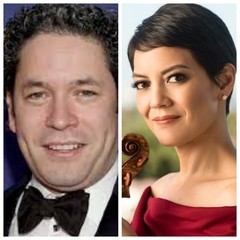|
Back
On Wings of Mezzo-American Song New York
Isaac Stern Auditorium, Carnegie Hall
10/26/2022 - & October 16 (Los Angeles), 28 (México), 2022
Gabriela Ortiz: Kauyumari (NY Premiere)
Arturo Márquez: Fandango for Violin and Orchestra (NY Premiere)
Aaron Copland: Symphony No. 3
Anne Akiko Meyers (Violin)
Los Angeles Philharmonic, Gustavo Dudamel (Conductor)

G. Dudamel/A. A. Meyers
“Most people use music as a couch; they want to be pillowed on it, relaxed and consoled for the stress of daily living. But serious music was never meant to be soporific.”
Aaron Copland
Gustavo Dudamel’s two nights with the Los Angeles Philharmonic were–with a single exception–dedicated to the music of his own hemisphere. The one exception was the Mahler First Symphony on opening night. And even that work was as much about forest roots as Central European roots.
Last night, though, Mr. Dudamel provided two works from Mezzo‑America and one piece which was started in a small Mexican town and finished in New York. It was his world, and he ruled it.
Truth be told, the American work, Aaron Copland’s Third Symphony was impressive enough, and can certainly stand up with the Copland ballets. Somehow, though, Mr. Dudamel was too self-consciously whipping this together.
The movements were ultra‑brassy, three of them filled with tocsins, fanfares and huge booming drums. Even more important, Copland could “make up” American melodies which sounded like whistling‑tunes by Johnny Appleseed.
Most of all, this is spacious, roomy wide-open-prairie music. Mr. Dudamel has brought his LA Phil to the point where they would reveal all the sounds needed, though that was a bit of the problem. He engineered those sounds with a grandiloquence–rather than an eloquence. At times, one thought this a Concerto for Kettledrums and Orchestra rather than a symphony. (First Chair Joseph Peireira and his Gang of Six drummers were literally striking!)
Yet to this listener, the segue in the slow movement to a folkish dance, close to the dances of Appalachian Spring, gave us respite gave us a chance to hear Copland with a rare inward inspiration.
The two New York premieres, though, were the most memorable works here. The first, Gabriela Ortiz’ Kauyumari was a mere six minutes. But in those minutes, after a few solo sounds of an Amerindian song about the titular Blue Deer, the Mexican composer was exuberant, rhythmic, pounding, dance‑like. Like the mythical legendary Blue Deer itself dashing through the forest, appearing here, disappearing there, pursued yet never captured, those sounds were transformed, altered, peeking through the orchestra and melting away.
The great Russian director Sergei Eisenstein, while making his movie about Mexico, related how a bird, who didn’t exist, was actually the spirit of the dead, and did appear only when deeply need. This was also Ms. Ortiz’ Kauyumari. Hopefully it will appear in every orchestral repertory.
One cannot imagine that Arturo Márquez’ Fandango for Violin and Orchestra would ever be commonplace. The Concerto itself is a rainforest of impossible challenges. Yet Anne Akiko Meyers, for whom the work was written, soared through this jungle, her 1741 Guarneri del Gesù violin jumping, bouncing, playing the frequent high registers with operatic facility, the fandango rhythms of the eponymous work flying out with golden art.

A.Márquez/G. Ortiz
One might have asked how Arturo Márquez could have taken a particular rhythm...er dance...er, dancing rhythm, using it for a 36‑minute piece. Well, the Mexican composer, already reputed for his Danzón, understood the extended meaning of “fandango” itself, how it evolved from a slow North African dance to the more exuberant 15th Century Spanish dance through Mexico itself.
The rhythms, a syncopated triplet series, seemed to underline most of the work. Though Mr. Márquez’ himself unnervingly drifted into 19th Century showmanship. The opening could have been written by Max Bruch, the numerous short and long cadenzas were on the cusp of Wieniawski. Then again, the composer had 36 minutes to fill, and, rightly, never wanted to bypass Ms. Meyer’s genius.
The chaconne second movement was the only time the fandango rhythms were given a rest. Though Ms. Meyers’ dizzying passagework made one feel almost giddy.
(Add to this the composer’s written note that “the chaconne was forbidden by the Spanish Inquisition.” Not only “huh” and “insane”, but “Wow. What the hell hath God wrought??”).
Modestly, the composer wrote that the final movement “demands great virtuosity from the soloist.” That was an understatement. The entire Fandango Concerto demanded the utmost virtuosity from fiddler and Phil. Both Messrs Meyers and Dudamel played with every note taking off, taking wing and soaring into a musical stratosphere.
Harry Rolnick
|